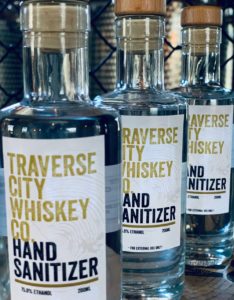How Whiskey-Makers Are Switching To Hand Sanitizer
By Richard Thomas

As a drinks writer, one of the mainstays of my news alerts, inbox and correspondence with my colleagues is the partial conversion of the distilling industry from making booze to making hand sanitizer. It’s reminiscent of the World War Two experience, when spirits-makers largely switched to producing industrial alcohol for the war effort.
In the 1940s, making industrial alcohol was a way to stay in business when fuel, grain and wood were all rationed commodities for civilian production, but not military production. Today, many a small distiller relies on venues that are now closed to go from breaking even to turning a profit: sales from their own bar or gift shop and sales to bars and restaurants. Some are donating their sanitizer output to first responders and healthcare institutions; others are selling them to the public for a modest price. In more than a few cases, survival as a business as much as altruism drives the switch from making booze to making sanitizer (Editor’s Note: thus far, I have not heard of a single instance of a distillery trying to sell sanitizer at profiteer-level prices).
Yet this hand sanitizer isn’t being made to uniform specs. That doesn’t mean it isn’t effective; any solution with an alcohol content of 60% or higher should kill all microbes it comes in contact with instantly. But each distillery has different equipment and its own unique take on the spirits production process, and thus each one of these response-driven issues of hand sanitizer from the spirits industry will be slightly different as well.
In Michigan, Traverse City Whiskey Company responded by gearing their production process from making whiskey to making something more like vodka, and taking it straight from the still and bottling it at 75% ABV without making any cuts. This underscores a key reason why the curious (or especially alcoholic) shouldn’t take a nip from a bottle of sanitizer that is in liquid rather than gel format: beyond simply being unpalatable, retention of the heads means the toxins that infamously made drinkers of Prohibition era bathtub gin and moonshine blind are there. These are harmless on your hands, but not in your liver.
I’ve actually seen some joking about drinking these response sanitizers made by distillers on social media, so I’ll be plain and direct about this: DON’T.
The response to Traverse City’s switch to making sanitizer has been typical. “The response and demand has been shocking,” said Chris Fredrickson, co-founder of Traverse City Whiskey Co. “We sold out of our initial inventory at The Stillhouse within an hour and received online orders for more than 10,000 units literally overnight. Because of this, we’ve evolved our initial strategy from retail to include medical and first responders, as that has been the greatest need.”
Gel, on the other hand, is something no one should want to consume. Treaty Oak Distilling in Texas is making sanitizer similar to what is found in most pre-pandemic brands, manufactured following the World Health Organization’s forumla. The distillery is using the highly distilled, high proof grain neutral spirits that serve as the base for their Waterloo No. 9 Gin, added glycerin, hydrogen peroxide and water, and have been releasing the mixture in 2 oz. bottles.
Finally, not everyone who is releasing hand sanitizer in the crisis is actually making it. Instead, some are sourcing the alcohol and using their bottling equipment and distribution resources. Catoctin Creek’s co-founder Scott Harris reported that they didn’t have the equipment to make sanitizer-grade alcohol in either the quantity or timeframe required, so they bought bulk ethanol from an industrial distillery and bottled it in liquid form.




